Much of the sociology of postcards seems to center around the content, i.e. the written message, but not as a medium in and of itself. While postcards were a means of communication, they went beyond that broad definition and were more specifically a communication device which changes their definition completely. The term "means of communication" is a generalization that can refer to any materials, processes, or instruments used to communicate such as a pen and paper, the very act of writing, a telephone, human speech, or the local newspaper. This is an important distinction in that a device refers to a physical object that can be mass produced. The picture postcard presents the recipient not just with a written message, but also with an image of objects, scenes, or people that may be familiar or unfamiliar to the viewer, in part or as a whole. For example, a person in a rural area would have heard about New York City, and may have read about it in the local newspaper; receiving a postcard with a scene of the city provided the recipient with a mental impression of what the city looked like and, perhaps, even imagined the noise of the big city.
From early in 1900 when photography was merged with high-speed printing presses postcards became mass-produced, mass-marketed communication devices that combined a hand-written or advertising message with an image that together carried a social impact; postcards were a medium in and of themselves with no less the social impact of a newspaper or the telegraph and telegram of the time. Vintage postcards, as communication devices, were by their very nature an intrinsic part of the continuous evolution of the Machine Age and high-speed production; first printed on steam-powered printing presses in the Industrial Age and then with electrically powered presses in the Machine Age. A card first started out as pulp in a paper mill and then was made into the correct weight and size of stock. Bought by a publishing house, it was then processed with the use of photography for photograph-based postcards, through the printing presses, and finally went through the mail system for delivery. The postcard brought the entire Machine Age, with origins deeply rooted in the early history of entire industries and and their respective technologies extending back through centuries, right into a person's hands. Vintage postcards that were based on photography more than a century ago reflected an era when the simplicity of everyday life continuing to be merged with Machine Age technology. Today, with the technology of the Digital Age, we use a much different process by electronically sending a quick note off to someone through an email or text message that may include an attached image and with its own social impact.
From early in 1900 when photography was merged with high-speed printing presses postcards became mass-produced, mass-marketed communication devices that combined a hand-written or advertising message with an image that together carried a social impact; postcards were a medium in and of themselves with no less the social impact of a newspaper or the telegraph and telegram of the time. Vintage postcards, as communication devices, were by their very nature an intrinsic part of the continuous evolution of the Machine Age and high-speed production; first printed on steam-powered printing presses in the Industrial Age and then with electrically powered presses in the Machine Age. A card first started out as pulp in a paper mill and then was made into the correct weight and size of stock. Bought by a publishing house, it was then processed with the use of photography for photograph-based postcards, through the printing presses, and finally went through the mail system for delivery. The postcard brought the entire Machine Age, with origins deeply rooted in the early history of entire industries and and their respective technologies extending back through centuries, right into a person's hands. Vintage postcards that were based on photography more than a century ago reflected an era when the simplicity of everyday life continuing to be merged with Machine Age technology. Today, with the technology of the Digital Age, we use a much different process by electronically sending a quick note off to someone through an email or text message that may include an attached image and with its own social impact.
The first years of the Twentieth Century ushered in a new era of landmark inventions and consumer products that would begin to change the nation and the world. Silent moving pictures were being watched, the use of electricity and light bulbs continued to spread, and both trolley and train travel had become a routine way of getting from one town to the next or from coast to coast. By 1900 there were nearly 600,000 telephones connected to Alexander Graham Bell's national telephone system and independent telephone companies built phones and installed wide-ranging systems of their own all over the country to connect people living in smaller and rural communities. The new Kodak Brownie camera was introduced for the price of one dollar. The battery-powered Columbia automobile was sold to hundreds of those who could afford them; in 1901 the Olds Motor Vehicle Co. of Lansing, Michigan, founded by Ransom E. Olds, produced 425 automobiles of their own on the first automotive assembly line. In 1900 the German inventor Count Ferdinand von Zeppelin flew his lighter-than-air dirigible almost four miles and with five passengers on board and was granted both European and a U.S. patent for his new dirigible. That same year Milton Hershey introduced his Hershey's milk chocolate bar to the world.
On December 23, 1900, Reginald Fessenden of Canada spoke through a microphone and transmitted the first clear message sent in human speech over a distance of fifty miles. The following year Guglielmo Marconi succeeded in sending the first radio transmission across the Atlantic consisting of the Morse code letter "S". In 1901 he built a radio station near South Wellfleet on Cape Cod, Massachusetts and from there, on January 18, 1903, he sent the first transatlantic voice radio message from the United States. It was a greeting from then-president Theodore Roosevelt to King Edward VII of the United Kingdom. King C. Gillette invented the first double-edged safety razor in 1901 and the first major oil boom was started with a single well in the "Spindletop" field in Beaumont, Texas. Henry Ford was still experimenting with his famous "quadricycle" at the time and sold just one that year. The Wright Brothers successfully tested a biplane at Kitty Hawk, North Carolina. Orville Wright took their "Flyer" for a twelve second, sustained flight on December 17, 1903, the same year the Ford Motor Company was founded.
The pace of life back then was only as fast as a the town trolley, a horse, or the local train could travel. Wood, cast iron, and steel formed the fabric and texture of the country and people did chores at home by hand; it was the only way that things got done. 1900 was also the start of what is called the “Golden Age” of postcards and lasted until the first world war. It was a time when legions of photographers around the world took photographs on glass-plate negatives; anything from cows and people to villages and towns, city scenes to monuments, railroad tracks to stations, and everything in between were produced on postcards. They were inexpensive, sold and sent around the world, and mass produced by the millions.
So, how were these vintage postcards made? Early vintage postcards that show real life scenes look like photographs because they were made from photographs and are the basis of the examples in my collection. They were not "hand-colored" postcards although hand-colored postcards were highly prized in the Victorian Era; cards of this type were mostly decorative, colored images. Most all of the photograph-based postcards were "retouched", something that will be discussed later, and were different from being "hand colored" or "hand-tinted". Some aspects of postcard printing remain a mystery because of long-gone company secrets are now lost to history through the passing of time, poorly kept records, and unknown processes from unknown printers. The technical history, in other words, was thrown away by progress. Even today there is conflicting and incomplete information, unexplained overlaps in processes, a vast number of inventors and improvements to processes, spotty histories, and many missing details.
The history of photography and printing are inseparable. As photography advanced, so did the printing technology and processes that reproduced them; this resulted in a corresponding expansion of new processes, further improvements to processes, and combinations of processes. In the sections below we will discuss four of the methods that made the printing of early photograph-based postcards possible: lithography, photogravure, collotype, and rotogravure.
Lithography


In 1798, Alois Senefelder, a German actor and playwright who couldn't afford to have his latest latest play, “Mathilde von Altenstein”, published on his own because publishing houses were too expensive. His ingenuity and determination led to a process that he called "chemical printing". He started out by using cut, high-quality limestone blocks from a quarry located in his hometown in Bavaria and were his printing “plates”. Senefelder found that it was possible to draw directly onto the stone using a type of early crayon, washes, or other artist materials as long as they contained a greasy ingredient. Quite by accident he discovered that when a solution containing salts was used, a chemical reaction to take place when the solution soaked into the open pores of the unpolished stone surrounding his drawing. When the solution was washed off, he discovered that areas he didn't want to hold ink would hold water instead. When he moistened the printing stone, he then applied a drawing by using an oil-based ink. The water repelled the ink and would only stick to the drawing. He went on to patent his process and named it lithography based on the Greek word "lithos" for stone. Senefelder's lithography process showed that an image could be made directly onto a printing surface and be used to print an image over and over again without having to engrave the surface first, as had been done for hundreds of years earlier. At the close of the 19th Century, however, photography and halftone technology became so widespread that many firms using standard lithography for illustrations and art prints went out of business.
Why is this Important for Postcards?
Reproduction of unengraved, printed images started with Senefelder's lithography process and its future development.
Photogravure
In 1858, William Talbot of England Talbot came up with a camera exposure process that started with only an extremely faint image exposed in the camera for up only a couple of minutes and with the subject in bright sunlight. The paper was then removed from the camera and chemically developed into a fully visible image. His iodized paper was the beginning of fixed images on something other than a small sheet of tin as in Louis Daguerre's process of the daguerreotype. Talbot's discovery of photographic paper and the ability to make multiple copies of a negative was a huge step forward toward modern photography and Talbot's goal of getting an image onto the printing press was coming closer to a reality. In 1852, Talbot introduced and patented a process of taking photographs through a textile screen, or veil, that would break an image up into tiny dots that could then be etched into tiny inkwells on a printing plate resulting in a reproduced image. In 1858 he patented a technique of dusting the plate with copal resin powder, an important ingredient in making furniture varnish and known for its hardness. This resulted in printed images a finer and more even tint. His early process would later come to be known as photogravure and the process that was used to deeply etch a flat copper plate would go on to be known as photoengraving.
Why is this Important for Postcards?
Talbot's camera veil was the first use of a device that was instrumental in the printing of photographs and our postcards. By the early 1900s in Europe, black and white postcards were often printed in color by combining Talbot's photogravure process with color lithography.
Rotogravure
William Talbot's revolutionary process of the halftone and the halftone screen was further developed by Karel Vaclav Klíc, a Bavarian artist and inventor living in Vienna. Klic devised a way of producing tones ranging, for example from solid black to a lighter tone of gray, and processed the range scale onto a printing plate in 1879. The image below shows a halftone range of black created by halftone.
 By placing a halftone screen a short distance in front of a developed photograph (the original was re-photographed) an optical effect took place: the darker parts of the image were converted to larger black squares, and the lighter parts of the image were converted to smaller black squares of the same intensity. Building upon Talbot's process, Klíc's basic approach was to was dust a plate with finely powdered resin and then heated until the resin melted into tiny mounds that hardened as they cooled. Acid was then applied to the metal plate which bit channels around the resin tiny droplets of resin. The result was an image with reticulation, an almost microscopic grain pattern that had the appearance of wrinkles or squiggles; the grain showed a capacity to hold more or less ink depending upon how long or how deeply the acid was allowed to penetrate the plate. By incorporating a rotary textile press, Talbot's halftone screen process, and a carbon tissue, a light-sensitive gelatin-based emulsion used in the chemical etching, Klíc developed the first rotogravure.
By placing a halftone screen a short distance in front of a developed photograph (the original was re-photographed) an optical effect took place: the darker parts of the image were converted to larger black squares, and the lighter parts of the image were converted to smaller black squares of the same intensity. Building upon Talbot's process, Klíc's basic approach was to was dust a plate with finely powdered resin and then heated until the resin melted into tiny mounds that hardened as they cooled. Acid was then applied to the metal plate which bit channels around the resin tiny droplets of resin. The result was an image with reticulation, an almost microscopic grain pattern that had the appearance of wrinkles or squiggles; the grain showed a capacity to hold more or less ink depending upon how long or how deeply the acid was allowed to penetrate the plate. By incorporating a rotary textile press, Talbot's halftone screen process, and a carbon tissue, a light-sensitive gelatin-based emulsion used in the chemical etching, Klíc developed the first rotogravure. The future evolution of black and white to color rotogravure was used widely for newspaper supplements and advertising and also for postcard printing. This will be discussed this further below.
Offset Lithography
A revolutionary printing method was invented that so greatly impacted printing that it became a dominant technology and is a standard method used even today: offset lithography and the offset printing press. Invented in England and patented In 1875 by Robert Barclay, the first offset lithographic printing press used a etched metal cylinders instead of flat lithographic stones. In the beginning a separate printing cylinder was covered with treated cardboard that transferred the image to the surface of a metal cylinder that would, in turn, print onto paper. Later, the cardboard covering of the offset cylinder was changed to rubber which is still the most commonly used material.
In 1901 the printer Ira Washington Rubel of New Jersey is said to have discovered, by forgetting to reload paper, that printing directly from the rubber roller instead of the metal plate resulted in a printed page that was clearer and sharper. This lead to the development of the offset printing press in 1903. In offset printing, the image cylinder is contacted by a series of rollers, each using its own ink tray for each color. The rubber roller picks up the image to be transferred as paper passes through and the impression cylinder applies pressure to print the image. All of this takes place as a synchronized, simultaneous action.
Why is this Important for Postcards?
Halftone color postcards are still printed using offset lithography today.
Hand-Colored and Hand-Tinted Postcards
Generic terms are often used interchangeably in order to describe a vintage postcard that was printed in color through a variety of processes such as "hand-colored" or "hand-tinted". Many postcards from the Victorian-era were created by artists as colored illustrations first and then printed. They became extremely popular with people who treasured them as works of art. The advertising postcard shown below is based on a painting as well. The second postcard is an example of a hand-tinted card based on a photograph. These cards were originally made by using watercolors, paints, and dyes applied slowly in layers. A sizing material was normally applied to the photograph first so the colorant wouldn't damage the surface; a light touch was needed because a heavy application of colorant would not dry evenly. Images courtesy Wikimedia Commons.

Retouching and Adding Features
As the postcard era expanded and the demand for color postcards increased, faster printing methods took over. The artists were replaced by retouchers whose job it was to fill in blank skies and enhance partially hidden details. Colors needed to be built up slowly and special oil-based paints were eventually designed for coloring. This was done by using artist's materials and was problematic because, if not carefully used in a production-like setting, they could blur the image and make it look bizarre. This was difficult and painstaking work. Often the retouchers, mostly women, were individually assigned to work on only one section. When that section of the photographic image was completed it was then passed along to another coworker. Features like skies or trees could be painted and photographed separately and easily for a "cut and paste" addition for future postcards. This was extended to a stock of people in period dress to populate a place where previously none existed. Automobiles, airplanes, and even zeppelins were available as ready-made decals and applied as well. There were also ready-made, single color halftone films used for adding in a sky blue or sea green color to cover large blank areas instead of having to be painted in. The use of out-of-scale or out-of-perspective decals often gave a rather strange, other-wordly look to postcards.
Why is this Important for Postcards?
Retouching is not seamless or undetectable. The painted sky is always a natural feature of color outdoor scenes from this era. Upon close inspection of many vintage railroad postcards, colored lines or shapes are visible where they were added in places so as to highlight details in darker areas. The edges of the end of freight or passenger cars and parts of a locomotive like piping were often colored in a brass tone. Many times the locomotive's driving wheels and car trucks (wheel assemblies) stand out when retouched because they just don't look completely realistic. Smoke and steam was often added, too, with a more or less convincing effect. A retoucher's poor rendering of a locomotive, passenger car, freight car, or of an entire train often made postcards look rather comical and cartoon-ish as can be seen in this detail of a circa 1912 postcard.
In this example, a circa late 1940s linen-era card, the airplane is clearly out-of-place and was most likely a decal.
Some Postcard Printing Examples
This view is of a section of track along the Bradford, Bordell & Kinzua Railroad in Pennsylvania. Note the fine details and colors. Looking at the coloration, the green tone on the right, between the tracks and the embankment, carries over and exactly follows the rail. On the left, notice how the green from the bushes carries over and follows half of the ties. This is a good indication that color addition was added using stop lines inherent in the card.

This is a high-resolution detail scan of the same postcard. The halftone screen dots clearly stand out and was probably printed through a rotogravure process.
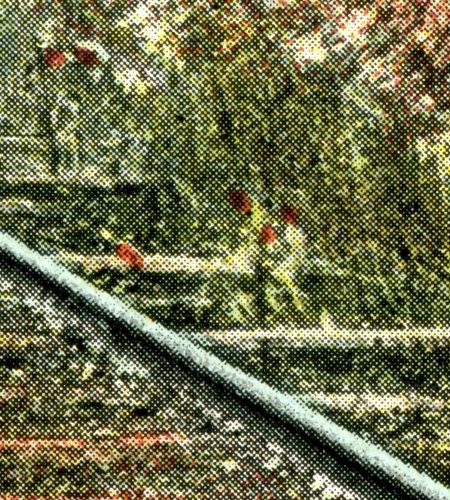
The card below shows less close-up detail with the subject being at a distance.
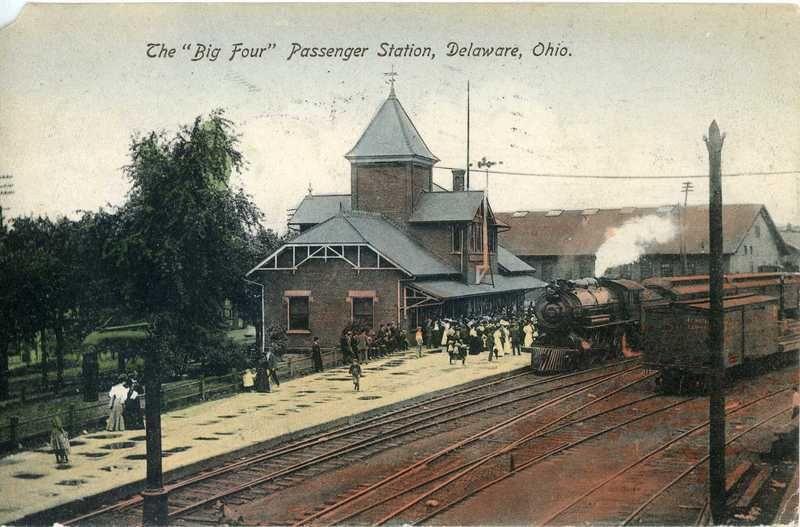

This is a high-resolution detail scan of the locomotive.


With higher resolution, the reticulation or squiggly pattern indicates the postcard was printed using the collotype process.

How Captions Were Added
Adding a caption to vintage postcards was a separate process. Because there was no way to accomplish this during the image processing, captions were later printed directly onto the card by using a letter press with movable type. For real photo postcards, however, a stencil or handwriting with white ink was added directly to the photograph and then rephotographed or was applied in reverse directly onto a negative. In addition to the captions on the cards above, here are a few more examples.



From the 1920s and up through the 1960s, the famous Western photographer William P. Sanborn traveled throughout Wyoming and Colorado photographing everything from towns and mines to general scenery and the narrow gauge railroads that were still operating at the time. In his real photo postcards, he added captions with his familiar signature in the lower right-hand corner.

In this card, it is suspected that an original card was rephotographed and a retoucher added a sloppy "cut-and-paste" pre-printed caption. The re-photographing and re-printing of existing postcards was frequently done resulting in a poorly produced postcard with a degraded image.

Some More Postcard Printing Examples
Here's an excellent example of a black and white callotype. The B&O "seal" herald on the lower right was stock artwork, probably a decal, that can be found on a number B&O issued cards. The crease was added later. Note that some of the printing on the bottom is cut off, The bottom of the card feels jagged as if it were separated from another card due to a perforation. This card was probably part of a part of a multi-view printed set run off on a sheet, perforated, and made up into a Z-fold packet. The card below, showing early "banjo" signals, is postmarked 1912.
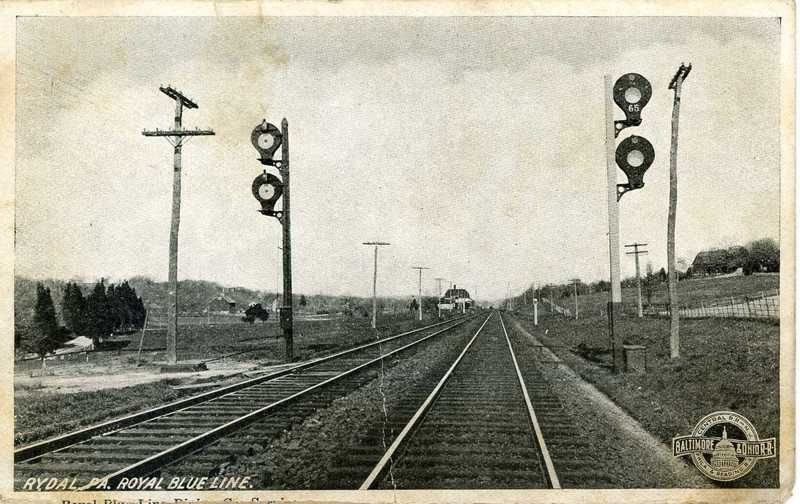
In this view, part of a perforated multi-card set, we see how bizarre the artwork of retouching can be. The people look terrible, especially the woman sitting with the little girl at the table on the right. The woman on the left, with her back towards us, seems ghostly with faded hair and pale violet dress. This may have been a cut-and-paste project where some of the people had their origins elsewhere.

In the scanned high-resolution image below we can see the rosette halftone pattern that was made by rotating the screens.
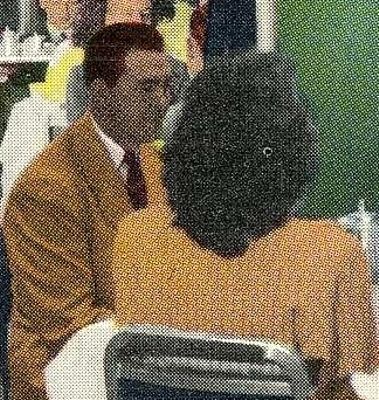
In this final card, a local commuter train has stopped in Wakefield Junction on the Boston & Maine's line connecting with Boston.
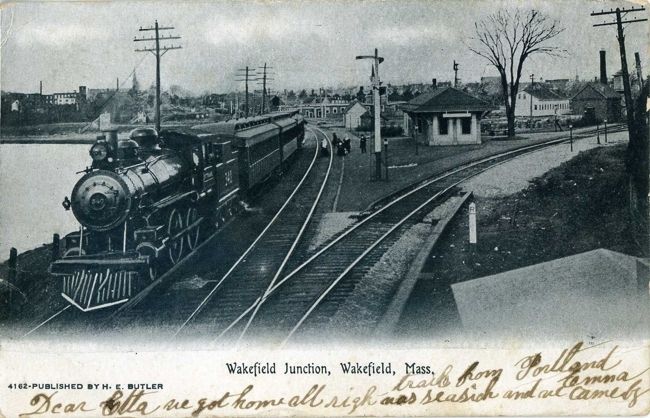
In this high-resolution below notice the halftone screen dots. The white lines on the pilot, and the curved lines on the drivers are evidence of a retoucher's work. in order to make these details stand out, they were drawn in with white paint or ink on the original photograph prior to being re-photographed and processed.

The Real Photo Postcard (RPPC)
In 1903 Kodak introduced the model 3A Folding Pocket Kodak camera as shown below in a period advertisement. The camera was designed for postcard-size film that would be developed on "postcard-back" photographic paper. The paper came pre-printed in the standard postcard format of 3-1/2" x 5-1/2" with a separate message section, an address section, and a box for the placement of postage then costing one cent for domestic delivery in the United States and two cents for delivery to other countries. A photograph was developed on the side without the printing. Kodak advertised the folding pocket camera as "photography with the bother left out." The 3A allowed photographers from around the world to travel from small villages to towns and from one city to another photographing everything from cows to people, from houses to monuments and buildings, and from local scenery to the town train station, as well as parades, fires, and floods, and the aftermath of earthquakes. They were used by realtors to sell new houses who then wrote descriptions and prices on the back. Local places of interest were made into RPPCs and were sold as souvenirs in local drug stores, stationery, and postcard shops. Aside from newspaper and professional photographers, consumers used the 3A to photograph their own homes, families, local schools, their farms, or anything else; with a photograph printed on postcard-back paper, it could be sent off to family members and friends anywhere in the country or the world. Image courtesy Duke University Digital Library Collection.

Designed for both professional the serious amateur photographers alike, the Soho Reflex camera was a British large-format, single-lens reflex camera produced from about 1905 to the 1940s. Available in a variety of formats for different uses, it also could be bought in the 3-1/2" x 5-1/2" postcard format. Reflex cameras enabled the photographer to view the image through a focusing screen with the lens open until the moment before exposure. The photograph below shows the camera with its folding hood, used for viewing the focusing screen, and lens cover raised. Image courtesy Wikimedia Commons.
In Closing
Much more information can be found on-line by searching for the italicized keywords found in this article. It is impossible to cover all aspects of the printing of postcards or of postcards in general in just one article, however I highly recommend reading through the excellent postcard reference website metropostcard.com. Here you will find topics ranging from printing technology to postcard artwork, from collecting to postcard history and genres. As always, additional information is always welcome and I would be glad to answer questions or provide a direction that may be of help.






2 comments:
Awesome! It’s genuinely awesome article, I even have got obvious idea concerning from this article. EDDM PRINTING
Victorias hockey club of 1897, President of Guelph's Fat Stock Club, and a member of the commission that renovated Woodlawn Cemetery, among many other things. post card printing
Post a Comment